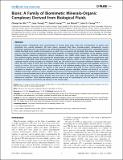Bions: A Family of Biomimetic Mineralo-Organic Complexes Derived from Biological Fluids
Author(s)
Wu, Cheng-Yeu; Young, Lena; Martel, Jan; Young, John D.; Young, David Y.
DownloadWu-2013-Bions_ A Family of B.pdf (4.919Mb)
PUBLISHER_CC
Publisher with Creative Commons License
Creative Commons Attribution
Terms of use
Metadata
Show full item recordAbstract
Mineralo-organic nanoparticles form spontaneously in human body fluids when the concentrations of calcium and phosphate ions exceed saturation. We have shown previously that these mineralo-organic nanoparticles possess biomimetic properties and can reproduce the whole phenomenology of the so-called nanobacteria—mineralized entities initially described as the smallest microorganisms on earth. Here, we examine the possibility that various charged elements and ions may form mineral nanoparticles with similar properties in biological fluids. Remarkably, all the elements tested, including sodium, magnesium, aluminum, calcium, manganese, iron, cobalt, nickel, copper, zinc, strontium, and barium form mineralo-organic particles with bacteria-like morphologies and other complex shapes following precipitation with phosphate in body fluids. Upon formation, these mineralo-organic particles, which we term bions, invariably accumulate carbonate apatite during incubation in biological fluids; yet, the particles also incorporate additional elements and thus reflect the ionic milieu in which they form. Bions initially harbor an amorphous mineral phase that gradually converts to crystals in culture. Our results show that serum produces a dual inhibition-seeding effect on bion formation. Using a comprehensive proteomic analysis, we identify a wide range of proteins that bind to these mineral particles during incubation in medium containing serum. The two main binding proteins identified, albumin and fetuin-A, act as both inhibitors and seeders of bions in culture. Notably, bions possess several biomimetic properties, including the possibility to increase in size and number and to be sub-cultured in fresh culture medium. Based on these results, we propose that bions represent biological, mineralo-organic particles that may form in the body under both physiological and pathological homeostasis conditions. These mineralo-organic particles may be part of a physiological cycle that regulates the function, transport and disposal of elements and minerals in the human body.
Date issued
2013-09Department
Massachusetts Institute of Technology. Department of Materials Science and EngineeringJournal
PLoS ONE
Publisher
Public Library of Science
Citation
Wu, Cheng-Yeu, Lena Young, David Young, Jan Martel, and John D. Young. “Bions: A Family of Biomimetic Mineralo-Organic Complexes Derived from Biological Fluids.” Edited by Wei-Chun Chin. PLoS ONE 8, no. 9 (September 25, 2013): e75501.
Version: Final published version
ISSN
1932-6203